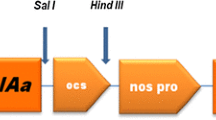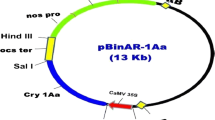Abstract
A binary vector carrying Bacillus thuringiensis cry1Ia8 and cry1Ba3 genes was introduced into an inbred line of white cabbage by Agrobacterium tumefaciens-mediated transformation for control of diamondback moth (DBM, Plutella xylostella), and 14 kanamycin-resistant plantlets were obtained. Presence and expression of the cry1Ia8 and cry1Ba3 genes in five transformed plants were confirmed by polymerase chain reaction (PCR), Southern blot, reverse transcription-polymerase chain reaction (RT-PCR), and Western blot analyses. Insect bioassays showed that these transgenic plants were able to effectively control both susceptible and Cry1Ac-resistant DBM larvae as compared to non-transformed counterparts. Ten homozygous insect-resistant cabbage lines were obtained in the T2 generation through self-pollination, and molecular methods and insect bioassays. After natural infestation under greenhouse and field conditions, the pyramided lines exhibited excellent efficacy against DBM. Furthermore, data from field trials indicated that there were no significant differences in most agronomic traits between most the homozygous lines and the original variety. These transgenic lines may allow field study of resistance management strategies involving gene pyramiding and serve as novel insect-resistant resources in cabbage breeding.







Similar content being viewed by others
References
Bagla P (2010) Hardy cotton-munching pests are latest blow to GM crops. Science 327:1439
Bates SL, Zhao J-Z, Roush RT, Shelton AM (2005) Insect resistance management in GM crops: past, present and future. Nat Biotechnol 23:57–62
Bhattacharya R, Viswakarma N, Bhat S, Kirti P, Chopra V (2002) Development of insect-resistant transgenic cabbage plants expressing a synthetic cryIA (b) gene from Bacillus thuringiensis. Curr Sci India 83:146–150
Bradd SJ, Dunn MJ (1993) Analysis of membrane proteins by western blotting and enhanced chemiluminescence. Biomembrane Protocols. Springer, Berlin, pp 211–218
Cao J, Zhao JZ, Tang J, Shelton A, Earle E (2002) Broccoli plants with pyramided cry1Ac and cry1C Bt genes control diamondback moths resistant to Cry1A and Cry1C proteins. Theor Appl Genet 105:258–264
Cao J, Shelton AM, Earle ED (2005) Development of transgenic collards (Brassica oleracea L. var. acephala) expressing a cry1Ac or cry1C Bt gene for control of the diamondback moth. Crop Prot 24:804–813
Cao J, Shelton AM, Earle ED (2008) Sequential transformation to pyramid two Bt genes in vegetable Indian mustard (Brassica juncea L.) and its potential for control of diamondback moth larvae. Plant Cell Rep 27:479–487
Cheng E (1988) Problems of control of insecticide-resistant Plutella xylostella. Pestic Sci 23:177–188
Cui L, Yang LM, Liu N, Lang ZH, Liu YM, Zhuang M, Zhang YY, Zhang YJ, Huang D, Fang ZY (2009) Transformation and expression of Bt gene cry1Ia8 in cabbage. Acta Horticulturae Sinica 36:1161–1168
Doyle JJ (1990) Isolation of plant DNA from fresh tissue. Focus 12:13–15
Dutta D, Niwas R, Gopal M (2012) Comparative persistence of thiacloprid in Bt-transgenic cabbage (Brassica oleracea cv. capitata) vis-a-vis non-transgenic crop and its decontamination. B Environ Contam Tox 89:1027–1031
Frutos R, Rang C, Royer M (1999) Managing insect resistance to plants producing Bacillus thuringiensis toxins. Crit Rev Biotechnol 19:227–276
Furlong MJ, Wright DJ, Dosdall LM (2013) Diamondback moth ecology and management: problems, progress, and prospects. Annu Rev Entomol 58:517–541
Gahan LJ, Ma YT, MacGregor Coble ML, Gould F, Moar WJ, Heckel DG (2005) Genetic basis of resistance to Cry1Ac and Cry2Aa in Heliothis virescens (Lepidoptera: Noctuidae). Journal Econ Entomol 98:1357–1368
Gassmann AJ, Petzold-Maxwell JL, Keweshan RS, Dunbar MW (2011) Field-evolved resistance to Bt maize by western corn rootworm. PLoS ONE 6:1–7
Halpin C (2005) Gene stacking in transgenic plants–the challenge for 21st century plant biotechnology. Plant Biotechnol J 3:141–155
Jackson R, Bradley J, Van Duyn J (2003) Field performance of transgenic cottons expressing one or two Bacillus thuringiensis endotoxins against bollworm, Helicoverpa zea (Boddie). J Cotton Sci 7:57–64
James C (2012) Global status of commercialized biotech/GM Crops: 2012. ISAAA Brief No. 44. ISAAA, Ithaca
Jin RG, Liu YB, Tabashnik B, Borthakur D (2000) Development of transgenic cabbage (Brassica oleracea var. capitata) for insect resistance by Agrobacterium tumefaciens-mediated transformation. In Vitro Cell Dev-Pl 36:231–237
Larson E, Howlett B, Jagendorf A (1986) Artificial reductant enhancement of the Lowry method for protein determination. Anal Biochem 155:243–248
Liu H, Guo X, Naeem MS, Liu D, Xu L, Zhang W, Tang G, Zhou W (2011) Transgenic Brassica napus L. lines carrying a two gene construct demonstrate enhanced resistance against Plutella xylostella and Sclerotinia sclerotiorum. Plant Cell Tiss Org Cult 106:143–151
Macharia I, Löhr B, De Groote H (2005) Assessing the potential impact of biological control of Plutella xylostella (diamondback moth) in cabbage production in Kenya. Crop Prot 24:981–989
Maqbool SB, Riazuddin S, Loc NT, Gatehouse AM, Gatehouse JA, Christou P (2001) Expression of multiple insecticidal genes confers broad resistance against a range of different rice pests. Mol Breeding 7:85–93
Matten SR, Head GP, Quemada HD (2008) How governmental regulation can help or hinder the integration of Bt crops within IPM programs. Integration of Insect-Resistant Genetically Modified Crops within IPM Programs. Springer, Berlin, pp 27–39
Mersereau M, Pazour GJ, Das A (1990) Efficient transformation of Agrobacterium tumefaciens by electroporation. Gene 90:149–151
Metz TD, Dixit R, Earle ED (1995) Agrobacterium tumefaciens-mediated transformation of broccoli (Brassica oleracea var. italica) and cabbage (B. oleracea var. capitata). Plant Cell Rep 15:287–292
Murashige T, Skoog F (1962) A revised medium for rapid growth and bioassays with tobacco tissue cultures. Physiol Plantarum 15:473–497
Rafat A, Aziz MA, Rashid AA, Abdullah SNA, Kamaladini H, Sirchi M, Javadi M (2010) Optimization of Agrobacterium tumefaciens-mediated transformation and shoot regeneration after co-cultivation of cabbage (Brassica oleracea subsp. capitata) cv. KY Cross with AtHSP101 gene. Sci Hortic 124:1–8
Roush R (1998) Two–toxin strategies for management of insecticidal transgenic crops: can pyramiding succeed where pesticide mixtures have not? Philos Trans R Soc Lond B Biol Sci 353:1777–1786
Sambrook J, Fritsch EF, Maniatis T (1989) Molecular cloning: a laboratory manual. Cold Spring Harbor Laboratory Press, New York
Talekar N, Shelton A (1993) Biology, ecology, and management of the diamondback moth. Annu Rev Entomol 38:275–301
Tu J, Zhang G, Datta K, Xu C, He Y, Zhang Q, Khush GS, Datta SK (2000) Field performance of transgenic elite commercial hybrid rice expressing Bacillus thuringiensis δ-endotoxin. Nat Biotechnol 18:1101–1104
Van Rensburg J (2007) First report of field resistance by the stem borer, Busseola fusca (Fuller) to Bt-transgenic maize. South African Journal of Plant and Soil 24:147–151
Wang G, Zhang J, Song F, Gu A, Uwais A, Shao T, Huang D (2008) Recombinant Bacillus thuringiensis strain shows high insecticidal activity against Plutella xylostella and Leptinotarsa decemlineata without affecting nontarget species in the field. J Appl Microbiol 105:1536–1543
Yang Z, Chen H, Tang W, Hua H, Lin Y (2011) Development and characterisation of transgenic rice expressing two Bacillus thuringiensis genes. Pest Manag Sci 67:414–422
Yang ZX, Wu QJ, Wang SL, Chang XL, Wang JH, Guo ZJ, Lei YY, Xu BY, Zhang YJ (2012) Expression of cadherin, aminopeptidase N and alkaline phosphatase genes in Cry1Ac-susceptible and Cry1Ac-resistant strains of Plutella xylostella (L.). J Appl Entomol 136:539–548
Ye X, Al-Babili S, Klöti A, Zhang J, Lucca P, Beyer P, Potrykus I (2000) Engineering the provitamin A (β-carotene) biosynthetic pathway into (carotenoid-free) rice endosperm. Science 287:303–305
Yi DX, Cui L, Liu YM, Zhuang M, Zhang YY, Fang ZY, Yang LM (2011) Transformation of cabbage (Brassica oleracea L. var. capitata) with Bt cry1Ba3 gene for control of diamondback moth. Agr Sci China 10:1693–1700
Zhao JZ, Cao J, Li Y, Collins HL, Roush RT, Earle ED, Shelton AM (2003) Transgenic plants expressing two Bacillus thuringiensis toxins delay insect resistance evolution. Nat Biotechnol 21:1493–1497
Zhao JZ, Cao J, Collins HL, Bates SL, Roush RT, Earle ED, Shelton AM (2005) Concurrent use of transgenic plants expressing a single and two Bacillus thuringiensis genes speeds insect adaptation to pyramided plants. P Natl Acad Sci USA 102:8426–8430
Acknowledgments
We are grateful to Prof. Dafang Huang, Prof. Jie Zhang, and Dr. Zhihong Lang for providing Bt genes and vector. We thank Prof. Youjun Zhang for their help in sending us the DBM larvae. Thanks are due to Prof. Elizabeth Earle (Department of Plant Breeding & Genetics, Cornell University, USA) for constructive advice on writing the manuscript and to Dr. Jun Cao (Athenix Corporation, USA) for providing the Brassica genetic transformation protocol. This work was supported by grants from the National High Technology Research and Development Program of China (863 Program, No. 2008AA10Z155), the National Natural Science Foundation of China (No. 31071697), and the earmarked fund for Modern Agro-industry Technology Research System (No. nycytx-35-gw01).
Author information
Authors and Affiliations
Corresponding author
Rights and permissions
About this article
Cite this article
Yi, D., Cui, L., Wang, L. et al. Pyramiding of Bt cry1Ia8 and cry1Ba3 genes into cabbage (Brassica oleracea L. var. capitata) confers effective control against diamondback moth. Plant Cell Tiss Organ Cult 115, 419–428 (2013). https://doi.org/10.1007/s11240-013-0373-4
Received:
Accepted:
Published:
Issue Date:
DOI: https://doi.org/10.1007/s11240-013-0373-4




